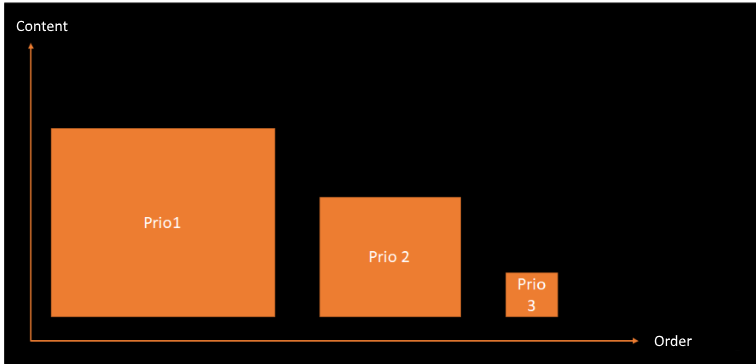Get the best feedback from the demo
2017-10-28Have you ever been to a demo where the team spend almost all of the time to present how and what they have done and very tittle time on getting feedback from the participants? This will not give us the excellent feedback that we want. I think we can have a better approach in the demo to get really good feedback.
To start with feedback is the most important point of the demo! To be able to get feedback we need to first show what the team has accomplished.
So, what we want to solve is to first of all get feedback and secondly get really good feedback. Let's start with some things to make sure that you get feedback at all.
Feedback prioritized agenda
Frist of all we need to make sure that we have enough space in our agenda for the demo to get feedback. For this reason, we should timebox the items we have in the demo agenda, to make sure each and every one gets enough time for receiving feedback. But if we for some reason will not be able to hold the timebox that was set, we should take the item that we mostly want feedback on first in the demo. The thing that you mostly want feedback on, is probably not the thing that you are mostly proud of in the demo, it's instead the item that you are not really sure how to implement. You should also be very clear on what you want feedback on, already from the beginning.

Definition – Feedback prioritized agenda: A timeboxed agenda with the times you want feedback on first.
Let users try
If you compare listening to someone telling you about a new feature with if you try the new feature yourself. Testing the feature, yourself will give you a much deeper understanding of how the feature really works. There could be tiny details that you will not discover when someone is just showing you how it works. These tiny details, could be the difference between if the new feature is super good or really horrible to work with. Also, if you are doing something more actively your brain, will trigger more association and in the end more feedback regarding a specific feature. And feedback is what we want.
Definition – Let users try: The people in the demo, should be able to test the new feature on their own computer.
Get the correct feedback
You have probably heard that first impression lasts. The same goes for a reference point. It works like this: If we in the demo for instance ask for feedback about how many lines of data that should be displayed on the new page that we have built. Then one person say that 10 lines would be good. Now the reference point for this question has become 10 rows. After this all other participants in the demo is thinking if their opinion is that it should be more or less then 10 rows on the page.

Let me give you another example that I have heard about. It was an experiment done at the San Francisco Exploratorium, where the subject was asked these two questions.
- Do you think the highest red wood tree was higher or lower then 366 meters?
- How high do you think the highest red wood tree is?
The average answer the subjects gave to the second question was 257 meters.
Then there was a second group that got exactly the same questions, except instead of 366 meters the first question said 55 meters. For this group the average answer to the second questions was 86 meters. As you see there it was a very big difference between the 257 and 86 meters. The only difference here was that the two different groups got different reference number in the first question.
The conclusion of this is that it's very important how you ask a question. A good way is to ask a more open question like "How many rows should be visible on the new page?" and then let the participants give the answer in a written form, so that they don't affect each other.
Definition – Get the correct feedback: Ask open questions and don't let the participants affect each other.
Collect everybody's feedback
Maybe you have noticed that it's very common that one person is dominant in a conversation, meeting or demo. In the demo we are interested in getting everybody's opinion, not just the strongest persons in the room.

In a research project at Royal Institution of Technology in Sweden, they are look at how humans take turns in a conversation. They have developed a robot that can understand when there is an opportunity for someone else to speak and also count how much each person is speaking. What they have found in this project is that it's very common that there is a dominant person in a conversation. So, this is not good for our demo when maybe only one person is speaking and the others are quiet, we want everybody's opinion. In this research project the researchers have used the robot to try different ways to give the word to another person to speak. They for instance tried an open question like "do any of you have any feedback". That resulted in that the already dominant speaker would get even more dominant. So that was not a good way to improve. But something that worked better was to ask a question that is directed to one of the persons that where not dominant in the meeting, like "do Lisa have any feedback". With this type of question, the robot managed to even out the amount of time each person was speaking in a meeting. So, this will be a good approach for the demo moderator to use then.
Another good way that I have tried, on how to get everybody's opinion on some feature that I would like to have feedback on. Is to get the demo audience to vote what way would be the best way to implement a feature.
Definition – Get everybody's feedback: To get everybody opinion, you need to ask them directly or letting everybody to vote.
After the demo
It's easy to think that we got all the feedback during the demo. But it's very common that someone after the demo come to think about another aspect or a new idea. But how can they share that after the demo has ended? You should keep some kind of open channel for more feedback open sometime after the demo also. This channel could be as simple as specific demo mail account.
Summary
Now you got a lot of tips and tricks on how to get the best possible feedback out of your demos. But I have to warn you, you can destroy all that good work if the participants feel like there is too little time to give feedback on the demo. Because if the think that there is not enough time on the demo to give feedback they will not say anything at all, then the whole purpose of the demo is lost. Since the most important reason for having the demo is to get feedback.
I hope you will try some of these demo techniques on your next demo!